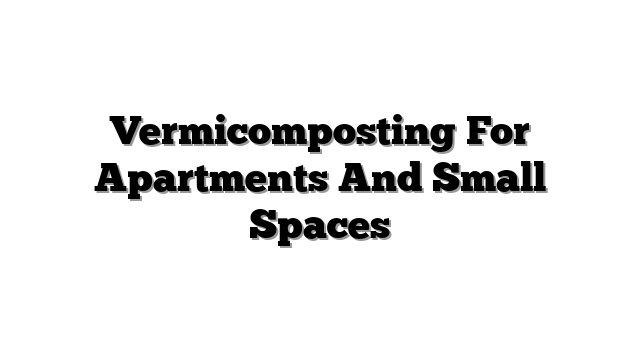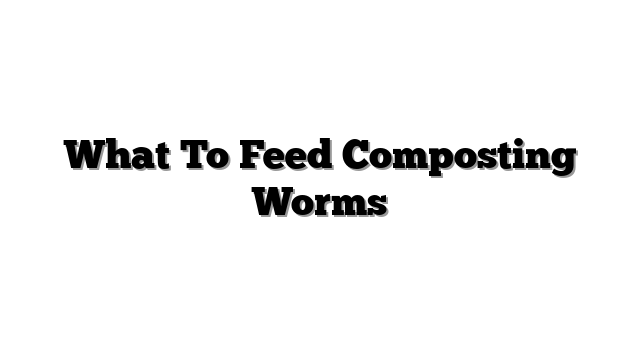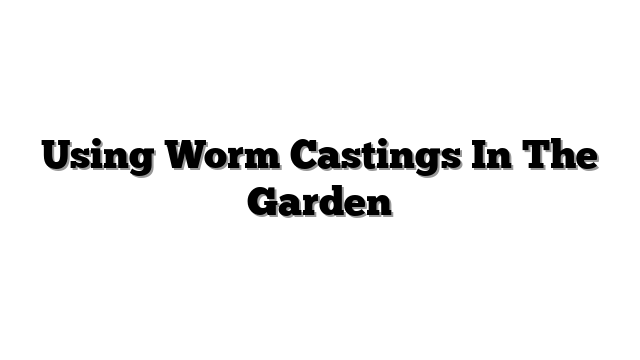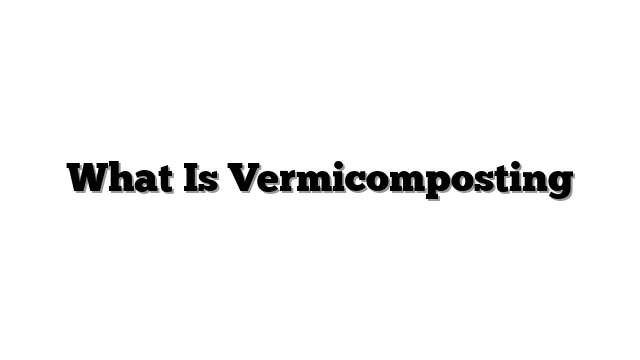Vermicomposting For Apartments And Small Spaces
Vermicomposting for Apartments & Small Spaces: Your Easy Indoor Guide
Love gardening but live in an apartment? Wish you could compost kitchen scraps? You can do this without a big backyard. No messy pile needed. What if you turned food waste into plant food? Right inside your home. This is possible.
Kitchen waste can be a problem. It fills up trash cans. It goes to landfills. But it holds value. It has energy. It has nutrients. Your plants need nutrients.
Meet vermicomposting. It uses special worms. These worms eat organic matter. They turn it into something amazing. This is worm poop. We call it castings. Worm castings are plant food.
This guide helps you start. We cover everything. Set up your bin. Choose your worms. Learn feeding and care. Harvest your compost. Solve common problems. Get ready for happy plants.
This works for apartments. It works for small spaces. You can grow better plants. You can help the planet. It starts with a bin. A few worms. Your food scraps. It is simple. It is rewarding. This is sustainable living.
The Apartment Composting Solution: Why Worms?
Traditional composting needs space. It needs a yard. Maybe a big pile. Apartments have little space. Balconies are small. Kitchens are cozy. Vermicomposting fits. It needs little room.
You can put a bin indoors. A closet works. Under a sink works. A balcony is fine too. It keeps waste out of landfills. We reduce food waste this way. This helps the Earth. It feels good.
Worms work fast. They break down food quickly. Faster than a compost pile. They make rich fertilizer. This is organic plant fertilizer. It is called worm castings. Castings feed your plants well.
People worry about smell. A healthy worm bin does not smell bad. It smells like earth. Like soil after rain. We talk about odor control later. Done right, it is odorless composting.
It takes little effort. Set it up. Feed the worms. Check on them. It is low maintenance. It is part of eco-friendly gardening. It fits urban gardening.
The best worms for this job are Red wigglers. Their science name is Eisenia fetida. They eat food scraps well. They live in bins easily. Regular earthworms dig deep. They do not work well in bins. Red wigglers stay near the surface. They eat the food you give them.
Worm castings are special. They are a superior organic plant fertilizer. They improve soil health. They help plants grow strong. They make plants happy. A little goes a long way.
Your First Step to Black Gold: Choosing and Setting Up Your Bin
You need a home for your worms. This is your indoor worm bin. You have choices.
Plastic storage bins work well. They are cheap. You can find them anywhere. You can make one yourself. This is a DIY bin. Drill small holes for air. Holes in the lid help. Holes near the top sides help. Worms need air.
Stacking systems are popular. They have trays. Worms start in the bottom tray. As they eat, you add a new tray on top. Worms move up to find food. Castings stay below. This makes harvesting easier. These are flow-through systems.
Wooden bins are possible. But they can be tricky indoors. Wood holds moisture differently. It can get too wet. Plastic bins are often better for apartments.
Think about bin size. How much food waste do you make? A small family might use a small bin. Maybe 10 gallons. A larger family needs bigger. Maybe 20 gallons. The bin should hold about one pound of food scraps per square foot each week. Start smaller if you are new. This is beginner composting.
Pick a good spot. Worms like steady temperatures. Not too hot. Not too cold. Avoid direct sun. A closet is good. Under a counter works. A laundry room corner. Find a place out of the way.
Now, prepare the bedding material. Bedding is the worm’s home. It holds moisture. It is part of their food. Good bedding is important.
Shredded paper is excellent. Use newspaper. Avoid the shiny, colored ads. Office paper works. Cardboard is also great. Tear it into small pieces. Coconut coir is very popular. It holds water well. Peat moss is another option. Mix different materials. It makes good bedding.
Prepare the bedding. Shred it first. Make pieces small. Then wet it. Use water. Squeeze it out. It should feel like a wet sponge. Not dripping wet. Just damp. Worms breathe through their skin. They need moisture.
Now add the worms. You need composting worms. Red wigglers are best. Where do you buy them? Online suppliers are common. Some garden centers sell them. Find a local source if you can.
How many worms? They sell them by weight. One pound is a good start. This is many worms. Maybe 1000 worms. They will eat about half their weight in food each day. One pound of worms eats about half a pound of food daily.
Put the damp bedding in the bin. Fluff it up. Make it loose. Add the worms gently. They will hide in the bedding. They need time to settle. Give them a few days. Do not feed them right away. Let them get used to their new home.
After a few days, feed them a little. A small amount of food scraps. Bury it in the bedding. This helps prevent fruit flies. Your worm bin setup is complete. You are ready for gardening for beginners, worm style.
Keeping Your Composting Crew Happy and Productive
Feeding worms is not hard. But you must feed the right things. This keeps the bin healthy. It keeps the worms happy.
What can they eat? Most fruit and vegetable scraps. Apple cores. Banana peels. Melon rinds. Coffee grounds are good. Used tea bags too. Crushed eggshells help. They add grit. Grit helps worms digest food. Plain bread or pasta is okay. Use small amounts. No sauces or oil.
What should they NOT eat? Avoid meat. No fish. No dairy products. No milk, cheese, yogurt. No oily foods. No spicy foods. Pet waste is bad. Do not add dog or cat poop. Diseased plants are a no. Plants treated with chemicals are bad.
Why avoid these things? Meat and dairy smell bad as they rot. They attract pests. Oily food is bad for worms. Spicy food can harm them. Pet waste has bad germs. Diseased plants spread problems. Chemicals hurt worms.
How and how often do you feed? Chop food into smaller pieces. Worms have no teeth. Small pieces break down faster. Bury the food scraps. Lift the bedding. Put food underneath. Cover it up. This stops fruit flies.
Start feeding small amounts. See how fast they eat. Do not add more food until they eat the last batch. Maybe feed every few days. Or once a week. It depends on how many worms you have. And how much food you add. Watch your worms. They will tell you.
Maintain optimal conditions. Worms like it just right. Moisture levels are key. Bedding should be like a wrung-out sponge. Squeeze it. Just a little water comes out. If it is too wet, add dry bedding. Shredded paper works well. If it is too dry, spray some water.
Aeration is important. Worms need air. Their home needs air. Gently turn the bedding sometimes. Use a small fork or trowel. Do not dig too deep. Just mix the top layer. This lets air in. It prevents compaction.
Temperature matters. Red wigglers like room temperature. Between 55 and 77 degrees F (13-25 C) is good. Keep the bin inside. Avoid hot sun. Avoid cold places.
Monitor your bin. Check on your worms often. How do they look? Are they active? Is the bedding damp enough? Does it smell okay? This is part of troubleshooting worm bin issues later. Good worm care leads to good castings. This means healthy plants.
Reaping the Rewards: Getting and Using Those Precious Worm Castings
You started your bin. You fed your worms. You waited. Now what? It is time for the black gold. This is finished worm castings.
How do you know it is ready? The bedding looks different. It is dark brown or black. It is crumbly. It smells earthy. Like good soil. You will see less original food. It takes time. Maybe 3-6 months for the first harvest.
Harvesting worm castings is exciting. There are simple methods.
One way is the “feed on one side” method. Stop feeding the whole bin. Put all new food on just one side. The worms move to that side. They want the fresh food. After a few weeks, one side has mostly castings. The other side has the worms. Scoop out the castings side. Put fresh bedding there. Start feeding on the other side next time.
Another way uses light. Worms do not like light. Dump the bin contents onto a plastic sheet. Make small piles. Shine a light on the piles. Worms go to the bottom of the piles. Gently scrape off the top layers of castings. Keep scraping. The worms will be left in small groups at the bottom. Put them back in the bin with fresh bedding.
Tray systems make it easy. Castings collect in lower trays. You just lift a tray. It is full of castings.
Sometimes you see brown liquid. This is compost leachate. It drips from the bin. It means the bin is too wet. It can smell bad. It might have bad bacteria. Do not use it directly on plants. You can add it back to the bin if it is dry. Or throw it out.
True worm tea is different. You make it. Mix castings with water. You can bubble air through it. This makes beneficial microbes grow. This is liquid plant food.
The power of worm castings is real. They are amazing for plants. Why? They are full of plant nutrients. Nitrogen, phosphorus, potassium. And many small nutrients. They have good microbes. These microbes help plants get food.
Castings improve soil structure. They make soil airy. They help soil hold water. They act like a slow-release organic plant fertilizer. They feed plants over time. No chemicals needed.
Compare them to chemical fertilizers. Chemicals give plants food fast. But they can harm soil life. Castings feed plants gently. They build healthy soil. Soil health is key for strong plant growth.
How to use your black gold? Mix castings into potting mix. Use them for container plants. This is perfect for apartment gardening. Or small space gardening. Use about 1 part castings to 4 parts soil.
Top dress your plants. Put a layer of castings on top of the soil. Water the plant. Nutrients soak down.
Make worm tea from castings. Put a cup of castings in a gallon of water. Let it sit. You can bubble air into it. Dilute this “tea.” Use it to water plants. Plant nutrients go right to the roots. This helps healthy plants grow.
Troubleshooting Your Indoor Worm Bin
Problems can happen. Do not worry. Most are easy to fix. This section helps with beginner composting issues.
Bad smells are common. This is not good. A healthy bin smells like earth. Bad smells mean something is wrong. Maybe it is too wet. This means not enough air. This is anaerobic. It smells sour or rotten.
Fixing odors? Add dry bedding. Shredded paper helps absorb wetness. Gently aerate the bin. Stir the top layer. Remove any food that smells very bad. Do not add too much food at once. Do not add forbidden foods. Odor control is simple once you know why.
Fruit flies can appear. They love rotting fruit. They are annoying. They get in through tiny spaces.
How to stop them? Bury food deeply. Cover it with bedding. Use a lid with small holes. You can use traps. Put apple cider vinegar in a cup. Add a drop of soap. Cover with plastic wrap. Poke small holes. Flies go in but cannot leave. Sticky traps also catch them.
Worms trying to escape? This is a sign. Conditions are not right. Maybe it is too wet. Or too dry. Maybe too hot or too cold. Too much food can make them leave. Too much acidic food (like lots of citrus) makes them unhappy.
Check moisture. Check temperature. Check food. Add dry bedding if wet. Spray if dry. Move the bin if hot or cold. Remove extra food. Add crushed eggshells if it might be too acidic. Correct the environment. Worms will stay.
Lots of mites might appear. Tiny white or brown bugs. They are usually harmless. They eat decaying food. But many mites mean conditions are too wet. Or too acidic.
Fix this by managing moisture. Add dry bedding. Add crushed eggshells. The mites will lessen. They are part of the bin’s life.
Worms dying? This means a big problem. Check the basics first. Is it too hot? Too cold? Is the bedding wet enough? Is it too wet? Is there air? Did you add bad food?
Go through a checklist. Temperature? Moisture? Air? Food type? Food amount? Find the issue. Fix it fast. Worms are sensitive. Worm bin problems can be solved.
Prevention is best. Keep conditions right. Do not overfeed. Add varied food. Bury food. This prevents most issues. Good worm care avoids trouble.
Your Vermicomposting Questions Answered
How long for first castings?
It takes time. A new bin needs maybe 3 to 6 months. Worms need to eat. They need to make castings. It depends on bin size. How many composting worms you have. How much you feed them.
Will my apartment composting bin smell?
No, it should not smell bad. A healthy indoor worm bin smells earthy. Bad smells mean problems. Too wet. Wrong food. Too much food. Fix the conditions. The odor control works.
What can I absolutely NOT put in my indoor worm bin?
Do not add meat. No dairy. No oily food. No spicy food. No pet waste. No diseased plants. No chemicals. These kitchen waste items harm worms. They cause smells. They attract pests. Stick to fruit and vegetable scraps.
How many composting worms do I need to start?
Start with about one pound of Red wigglers. This is a good amount for a small to medium bin. One pound of worms eats about half a pound of food each day. You can start with less. They will multiply.
Is worm tea the same as compost leachate, and how do I use it?
No, they are different. Compost leachate is liquid that drains from a wet bin. It might have bad things. True worm tea is made by mixing worm castings with water. It has good plant nutrients. Dilute true worm tea. Use it to water plants. Give plants nutrients. This helps plant health.
Start Your Apartment Vermicomposting Journey Today!
You learned a lot. Vermicomposting is easy. It is great for apartments. It works for small spaces.
It reduces your waste. It makes valuable organic plant fertilizer. It improves soil health. It helps plant growth. It is a sustainable living choice. Anyone can do it. No big yard needed.
It is a rewarding practice. You help the Earth. You get amazing plant food. This fits with urban gardening trends. People want to be eco-friendly at home. Maximize small spaces. Vermicomposting does this.
Start your bin today. Get some worms. Turn your food scraps into black gold. Your plants will thank you. It feels good to grow healthy plants. It feels good to waste less. Try it. See the difference.







